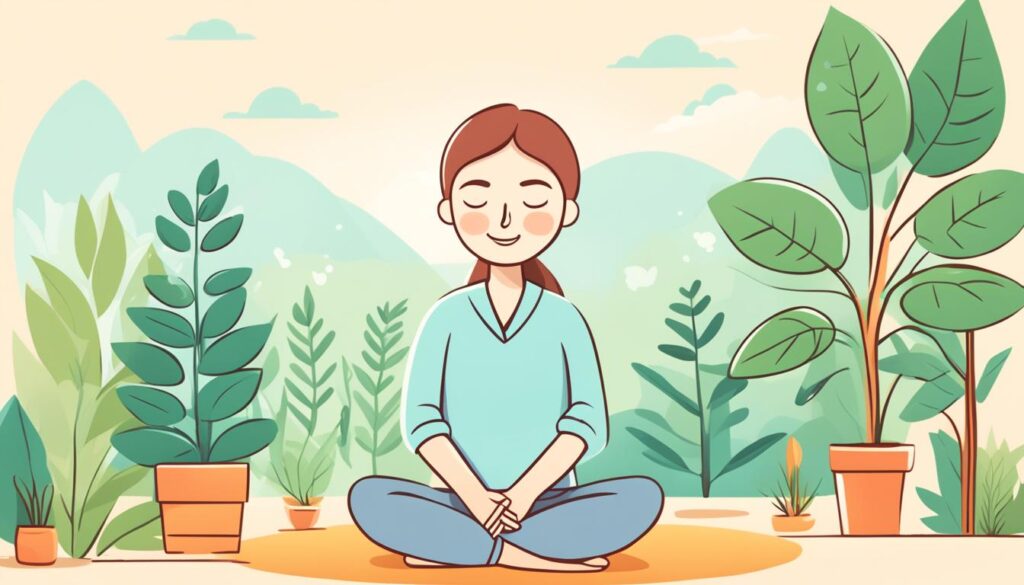Medically reviewed by Dr Chandril Chugh,
Renowned Neurologist and American Trained Specialist
Managing stress is essential for maintaining overall well-being. In today’s fast-paced world, stress can take a toll on your physical and mental health. That’s why incorporating relaxation techniques into your daily routine is so important. Taking the time to relax and unwind can help reduce stress levels, promote a sense of calm, and improve your overall quality of life.
Table of Contents
ToggleThere are various relaxation techniques that can help you manage stress effectively. From deep breathing to guided imagery, each technique offers its own unique benefits. By finding the relaxation techniques that work best for you, you can create a personalized stress management plan that suits your needs and lifestyle.
Key Takeaways:
- Managing stress is crucial for overall well-being.
- Relaxation techniques can help reduce stress levels.
- Deep breathing, guided imagery, and self-massage are effective techniques.
- Mindfulness and social support can also aid in stress management.
- Prioritizing self-care and setting boundaries is important for stress reduction.
1. Deep Breathing for Stress Relief
If you’re looking for a simple yet powerful technique to relieve stress, deep breathing is your answer. This relaxation method can be practiced anywhere and anytime, making it incredibly convenient.
To practice deep breathing, find a comfortable position, either sitting or lying down. Place one hand on your chest and the other on your stomach. Now, take a slow, deep breath in through your nose, allowing your breath to fill your belly. Feel your hand rise as your stomach expands with each inhalation.

Once you’ve inhaled fully, exhale slowly through your mouth, focusing on releasing any tension or stress as you breathe out. Feel your hand fall as your stomach contracts with each exhalation. Repeat this process for a few minutes, allowing yourself to completely relax and let go of any stress.
Deep breathing stimulates your body’s natural relaxation response, activating the parasympathetic nervous system and helping to reduce stress levels. It promotes a state of calmness and allows you to regain control over your mind and body.
You can enhance the stress-relieving effects of deep breathing by incorporating other elements like aromatherapy and music. Choose essential oils known for their calming properties, such as lavender or chamomile, and play soothing music in the background to create a serene ambiance.
Tips for Deep Breathing:
- Find a quiet and comfortable space where you can relax without distractions.
- Take slow, deep breaths, focusing on the sensation of your breath filling your body.
- Practice deep breathing regularly, ideally for at least 10 minutes a day.
- Combine deep breathing with other relaxation techniques, such as meditation or guided imagery, for enhanced stress relief.
- Experiment with different breathing patterns, like the 4-7-8 breath, to find what works best for you.
By incorporating deep breathing into your daily routine, you can effectively manage stress and experience a greater sense of calm and well-being.
| Benefits of Deep Breathing for Stress Relief | How to Practice Deep Breathing |
|---|---|
|
|
2. Progressive Muscle Relaxation
Progressive muscle relaxation is a highly effective technique for relieving muscle tension and promoting stress relief. By systematically tensing and then relaxing different muscle groups in your body, you can become more aware of tension and learn to consciously release it.
To practice progressive muscle relaxation, find a quiet and comfortable space where you can fully concentrate. Start by focusing on your breath, taking slow, deep breaths to center yourself.
Begin by tensing a specific muscle group in your body for about 5-10 seconds, then release the tension and let the muscle completely relax. As you tighten and relax each muscle group, pay attention to the sensations you experience, allowing yourself to fully let go of any tension or stress.
An example sequence for progressive muscle relaxation:
- Tensing: Start with your feet. Curl your toes tightly and hold for a few seconds.
- Relaxing: Release the tension in your toes and feel the muscles loosen.
- Tensing: Move on to your calves. Flex your calf muscles and hold the tension.
- Relaxing: Let go of the tension and allow your calf muscles to relax completely.
- Tensing: Continue this process, gradually working your way up to your thighs, abdomen, chest, arms, and finally, your face.
- Relaxing: After tensing and relaxing each muscle group, take a few moments to savor the feeling of relaxation that washes over your body.
Combining progressive muscle relaxation with deep breathing can amplify the benefits and enhance stress relief. As you tense and relax your muscles, focus on your breath, inhaling deeply and exhaling slowly to further calm your mind and body.
Regular practice of progressive muscle relaxation can help you manage muscle tension, reduce stress levels, and achieve a greater sense of relaxation and well-being.
3. Guided Imagery and Visualization
When it comes to finding relaxation and reducing stress levels, guided imagery and visualization techniques can be incredibly powerful. By directing your attention to specific scenes or images, you can create a sense of calm and tranquility within yourself.
To practice guided imagery and visualization, start by finding a quiet and comfortable space where you can fully concentrate. Close your eyes and imagine yourself in a serene setting, such as a beautiful beach or a peaceful wooded area. Visualize the surroundings in vivid detail, focusing on the sights, sounds, and sensations of that place.
Let yourself be fully immersed in the experience, as if you were physically there. Notice the gentle breeze on your skin, the sound of waves crashing, the warmth of the sun, and the scent of the ocean or forest. Allow these sensory details to transport you to a state of relaxation and tranquility.
You can practice guided imagery and visualization on your own or with the assistance of guided imagery recordings or apps. These resources provide step-by-step instructions and visualizations tailored to specific relaxation goals, such as stress relief, sleep improvement, or emotional well-being.
By incorporating guided imagery and visualization into your daily routine, you can effectively reduce stress and promote a sense of peace and relaxation. Take a few moments each day to indulge in this powerful technique and allow yourself to escape to a world of tranquility.

The Benefits of Guided Imagery and Visualization for Stress Relief
- Promotes relaxation and calmness
- Reduces anxiety and stress levels
- Enhances self-awareness and mindfulness
- Improves sleep quality
- Fosters a positive mindset
| Technique | Description | Benefits |
|---|---|---|
| Guided Imagery | Using external audio or visual cues to guide the mind towards a specific visual or sensory experience | – Helps distract from negative thoughts – Facilitates deep relaxation and stress reduction – Promotes emotional healing and well-being |
| Visualization | Mentally creating images or scenarios that generate positive emotions and induce a sense of calm | – Enhances focus and concentration – Reduces physical and mental tension – Boosts mood and overall well-being |
4. Self-Massage for Stress Reduction
When it comes to relieving stress and tension in your body, self-massage is a simple yet effective technique. With just a few minutes of self-care, you can experience deep relaxation and promote a sense of calm and well-being.
There are various self-massage techniques that you can try to release muscle knots and ease stress. You can use gentle strokes, tapping, or apply pressure to specific areas of your body. Focus on areas like your neck, shoulders, and face, as these are common areas where stress tends to accumulate.
To enhance the relaxation experience, consider incorporating scented lotions or oils into your self-massage routine. The soothing scent can further promote a sense of calm and relaxation. Additionally, combining self-massage with mindfulness or deep breathing techniques can amplify the stress-reducing benefits.
Take a moment to visualize yourself in a peaceful environment, and as you massage your body, focus on the sensations and let go of any tension or worries. Deep breathing during self-massage can help you relax further and release any built-up stress.
Remember, self-massage doesn’t have to be complicated or time-consuming. Even just a few minutes of self-care can go a long way in reducing stress and promoting relaxation.
Benefits of self-massage for stress reduction
Self-massage offers numerous benefits beyond stress reduction. Here are some key advantages:
- Relieves muscle tension and soreness
- Improves blood circulation
- Boosts mood and promotes a sense of well-being
- Reduces anxiety and stress hormone levels
- Enhances relaxation and quality of sleep
- Helps release endorphins, the body’s natural painkillers and mood elevators
- Can be done anywhere and anytime
By incorporating self-massage into your regular self-care routine, you can experience these benefits and better manage stress in your daily life.
| Steps for Self-Massage | Areas to Focus On |
|---|---|
| Gently apply scented lotion or oil to your hands | Neck |
| Warm up by using soft, sweeping strokes on your body | Shoulders |
| Apply gentle pressure and knead any muscle knots or tension | Face |
| Focus on specific areas that feel tense or sore | |
| Breathe deeply and let go of any stress or tension |
5. Mindfulness for Stress Management
Mindfulness is a powerful technique for effectively managing stress and promoting overall well-being. By focusing your attention on the present moment and accepting it without judgment, you can cultivate a sense of calm and reduce stress, anxiety, and negative emotions.
Practicing Mindfulness
There are various ways to practice mindfulness and incorporate it into your daily routine. One simple approach is to pay attention to your breath, senses, or bodily sensations. Take a few moments each day to bring your awareness to the present moment and observe your thoughts and feelings without judgment.
Mindfulness meditation is another effective technique for stress management. Find a quiet and comfortable place, close your eyes, and focus on your breath. As thoughts arise, gently let them go and bring your attention back to your breath. Regular meditation practice can help calm your mind and reduce stress levels.
Mindful eating is also an excellent way to practice mindfulness. Pay attention to the textures, flavors, and smells of your food. Eat slowly, savoring each bite, and fully engage your senses. By being present during meals, you can enjoy your food more and reduce stress-related eating habits.
The Benefits of Mindfulness
The practice of mindfulness offers numerous benefits for managing stress. It helps you develop a greater awareness of your thoughts and emotions, allowing you to respond to them in a more mindful and constructive way. By being fully present in the moment, you can avoid getting caught up in worries about the past or future, reducing stress and promoting mental well-being.
Mindfulness also enhances your ability to focus and concentrate, improving your productivity and efficiency. It increases self-awareness and self-compassion, allowing you to treat yourself with kindness and understanding, even during challenging times.
In addition to stress management, research has shown that mindfulness can have a positive impact on physical health. It can lower blood pressure, strengthen the immune system, and reduce chronic pain. By integrating mindfulness into your life, you can experience both mental and physical well-being.
Practice Mindfulness for Stress Relief
To start incorporating mindfulness into your stress management routine, try the following:
- Set aside a few minutes each day for mindfulness meditation.
- Find a quiet and comfortable space where you can sit or lie down without distractions.
- Focus on your breath, sensations in your body, or engage in guided mindfulness meditations.
- Practice mindful eating by savoring each bite and fully engaging your senses.
- Integrate mindful moments throughout your day, such as taking a mindful walk or engaging in mindful listening.
Remember, mindfulness is a skill that develops over time. Be patient with yourself and make it a regular practice. With consistency and dedication, you can harness the power of mindfulness to effectively manage stress and enhance your overall well-being.

| Mindfulness Benefits | The Practice of Mindfulness | Mindful Practices |
|---|---|---|
| Reduces stress, anxiety, and negative emotions | Focus on the present moment and acceptance without judgment | Regular mindfulness meditation |
| Improves focus, concentration, and productivity | Develops self-awareness and self-compassion | Mindful eating and savoring each bite |
| Enhances mental and physical well-being | Avoid getting caught up in past or future worries | Engaging in mindful moments throughout the day |
The table highlights the benefits of mindfulness, the practice of mindfulness, and various mindful practices that can be incorporated into daily life for stress management.
6. Laughter and Humor as Stress Relievers
Laughter is a powerful tool for relieving stress and promoting overall well-being. Not only does it make you feel good, but it also has scientifically proven benefits. When you laugh, your body releases endorphins, which are natural mood boosters. These endorphins help lower stress hormones, reduce tension in your muscles, and create a sense of relaxation. So, incorporating humor into your life can have both immediate and long-term positive effects on your stress levels.
There are plenty of ways to infuse laughter and humor into your daily routine. Surrounding yourself with funny friends, watching comedy shows, or listening to jokes and humorous anecdotes can instantly lighten your mental load and provide a much-needed break from stress. Even a pretend laugh can trigger physical changes in the body that mimic genuine laughter, leading to the same stress-reducing benefits.
Humor has the unique ability to change your perspective and bring a sense of joy to even the most challenging situations. It can help you let go of tension, shift your focus away from stressors, and create a more positive mindset. So, don’t be afraid to seek out opportunities for laughter and embrace humor as a valuable tool in your stress relief toolkit.

Benefits of Laughter and Humor
| Benefits | Description |
|---|---|
| Stress Reduction | Laughter releases endorphins, lowers stress hormones, and promotes relaxation. |
| Mood Enhancement | Humor boosts mood, increases happiness, and improves overall well-being. |
| Physical Health | Laughing improves cardiovascular health, boosts immunity, and enhances pain tolerance. |
| Relationship Building | Shared laughter strengthens relationships, fosters connection, and promotes bonding. |
| Coping Mechanism | Humor helps you cope with stress, adversity, and difficult emotions. |
As you can see, laughter and humor offer a wide range of benefits beyond just stress relief. So, make it a priority to incorporate laughter into your daily life. Surround yourself with funny people, watch funny videos, or read humorous books. Find what makes you laugh and actively seek out opportunities to bring more joy and humor into your day.
7. Healthy Lifestyle Habits for Stress Reduction
Maintaining a healthy lifestyle is crucial for managing stress. By making positive choices in your daily life, you can significantly reduce stress levels and promote overall well-being. Here are some healthy lifestyle habits that can help you effectively manage stress:
- Engage in Regular Physical Activity: Exercise is a powerful stress reducer. It releases endorphins, improves mood, and boosts energy levels. Aim for at least 30 minutes of moderate-intensity exercise, such as brisk walking, jogging, or cycling, most days of the week.
- Eat a Balanced Diet: A healthy diet plays a crucial role in reducing stress. Include plenty of fruits, vegetables, whole grains, lean proteins, and healthy fats in your meals. Avoid excessive consumption of processed foods, sugary snacks, and caffeinated beverages.
- Get Enough Sleep: Quality sleep is essential for stress reduction. Aim for 7-9 hours of uninterrupted sleep each night. Establish a relaxing bedtime routine and create a comfortable sleep environment to promote better sleep.
- Avoid Unhealthy Habits: Excessive consumption of caffeine or alcohol can increase anxiety and stress levels. Limit your intake of these substances and opt for healthier alternatives like herbal tea or infused water.
Taking care of your overall well-being is essential for long-term stress reduction. By incorporating these healthy lifestyle habits into your routine, you can effectively manage stress and improve your quality of life.
8. Social Support and Connection
Connecting with others can be a powerful stress reliever. Reach out to family and friends for support and social interaction. Even a simple coffee break or a phone call with a loved one can make a difference. Social contact provides distraction, support, and a sense of belonging, which can help you navigate the ups and downs of life more effectively. Additionally, volunteering for a charity can provide a sense of purpose and fulfillment while benefiting others.
Creating social support networks is essential for stress relief. When you surround yourself with positive and supportive people, you can share your thoughts and emotions, vent your frustrations, and receive valuable advice and encouragement. By maintaining strong social connections, you build a support system that can help you weather life’s challenges and reduce the burden of stress.
The Benefits of Social Support:
Research has shown that social support and connection have significant effects on stress relief and overall well-being. Here are some of the benefits:
- Emotional Support: Having someone to confide in and share your feelings with can provide comfort and reduce stress.
- Physical Health Improve: Strong social ties have been linked to improved immune function and faster recovery from illness.
- Reduced Risk of Mental Health Issues: Social support can help prevent or manage mental health conditions such as depression and anxiety.
- Increased Resilience: Social support networks can boost your ability to cope with difficult situations and bounce back from adversity.
When you connect with others, you not only benefit from their support but also have the opportunity to offer support in return. Acts of kindness and compassion can create a positive ripple effect, fostering a sense of connectedness and community.
Volunteering for Stress Relief
In addition to seeking social support, volunteering for a charity or community organization can provide numerous benefits for stress relief. By helping others, you not only contribute to a greater cause but also experience a sense of purpose and fulfillment. Volunteering can provide a welcome distraction from personal stressors and create a positive impact on both your mental and physical well-being.
When you engage in acts of service, you shift your focus from your own challenges to the needs of others, which can be incredibly therapeutic. Furthermore, volunteering can expand your social network, introduce you to new experiences and perspectives, and increase your overall sense of connectedness and belonging.
| Benefits of Social Support and Connection | Benefits of Volunteering for Stress Relief |
|---|---|
| Emotional support | Sense of purpose and fulfillment |
| Improved physical health | Positive impact on mental well-being |
| Reduced risk of mental health issues | Opportunity for personal growth and development |
| Increased resilience | Expanded social network and sense of belonging |
9. Setting Boundaries and Prioritizing Self-Care
Setting boundaries and prioritizing self-care is essential for effective stress management. It is important to learn how to say no when necessary and delegate tasks to lighten your load. Remember, putting yourself first is not selfish but rather a necessary act of self-preservation.
By valuing your own needs and well-being, you can prevent burnout and cultivate a sense of balance in your life. Prioritizing self-care activities, hobbies, and leisure time can help you recharge and effectively cope with stress.
Ways to Set Boundaries and Prioritize Self-Care
- Learn to say no when you feel overwhelmed or when additional commitments would cause excessive stress.
- Delegate tasks to others, whether it’s at work or in your personal life, to share responsibilities and lighten your load.
- Establish clear boundaries with others by communicating your needs and limitations in a respectful and assertive manner.
- Allocate time for self-care activities that bring you joy and relaxation, such as exercise, hobbies, or spending time in nature.
- Practice self-compassion and treat yourself with kindness and understanding. Avoid self-criticism or negative self-talk.
| Benefits of Setting Boundaries and Prioritizing Self-Care |
|---|
| 1. Reduces stress levels and prevents burnout. |
| 2. Enhances overall well-being and improves mental health. |
| 3. Improves productivity and focus by allowing sufficient time for rest and rejuvenation. |
| 4. Strengthens relationships by fostering clear communication and mutual respect. |
| 5. Increases self-confidence and empowerment by valuing your own needs and boundaries. |
Conclusion
Managing stress is crucial for maintaining overall well-being. By incorporating various relaxation techniques into your daily routine, you can effectively reduce stress levels and promote a sense of calm. Techniques such as deep breathing, progressive muscle relaxation, guided imagery, and self-massage can aid in stress management and provide much-needed relaxation.
In addition to these techniques, practicing mindfulness, embracing humor, and maintaining a healthy lifestyle are key factors in long-term stress reduction. Mindfulness allows you to be fully present in the moment, while laughter and humor help lighten your mental load. Prioritizing self-care and setting boundaries are equally important in managing stress effectively.
By implementing these stress management strategies into your life, you can experience the benefits of reduced stress levels and enhanced well-being. Start incorporating these relaxation techniques, mindfulness practices, and healthy habits today to find your Zen and achieve a balanced and fulfilling life.
FAQ
What are relaxation techniques?
Relaxation techniques are practices that help reduce stress levels and promote a sense of calm. They include deep breathing, meditation, progressive muscle relaxation, guided imagery, self-massage, visualization, and more.
Why is deep breathing recommended for stress relief?
Deep breathing is a simple yet powerful relaxation technique that can be practiced almost anywhere. By taking slow, deep breaths, you can activate your body’s natural relaxation response and reduce stress levels.
How does progressive muscle relaxation work?
Progressive muscle relaxation involves systematically tensing and relaxing different muscle groups in the body. By practicing this technique, you can become more aware of tension in your muscles and learn to relax them.
What is guided imagery and visualization?
Guided imagery and visualization involve focusing your attention on specific scenes or images to induce a state of relaxation. By visualizing calming scenes, you can reduce stress and promote a sense of tranquility.
How does self-massage help reduce stress?
Self-massage is a simple and effective way to relieve stress and tension in the body. By applying gentle strokes or pressure to muscle knots, you can release tension and promote relaxation.
What is mindfulness and how does it help with stress management?
Mindfulness involves focusing your attention on the present moment and accepting it without judgment. By practicing mindfulness, you can reduce stress, anxiety, and negative emotions, and cultivate a sense of calm.
How does laughter relieve stress?
Laughter is a natural stress reliever that releases endorphins, lowers stress hormones, and promotes a sense of well-being. Incorporating humor into your life can help lighten your mental load and reduce stress.
What lifestyle habits can help reduce stress?
Maintaining a healthy lifestyle is crucial for managing stress. Engaging in regular physical activity, eating a balanced diet, getting enough sleep, and avoiding unhealthy habits like excessive caffeine or alcohol consumption can significantly reduce stress levels.
Why is social support important for stress relief?
Connecting with others can be a powerful stress reliever. Reaching out to family and friends for support and social interaction provides distraction, support, and a sense of belonging, which can help you navigate the ups and downs of life more effectively.
How does setting boundaries and prioritizing self-care help with stress management?
Setting boundaries and prioritizing self-care is essential for managing stress. Learning to say no and delegating tasks can lighten your load and prevent burnout. Valuing your own needs and well-being allows you to cultivate a sense of balance in your life and effectively cope with stress.
